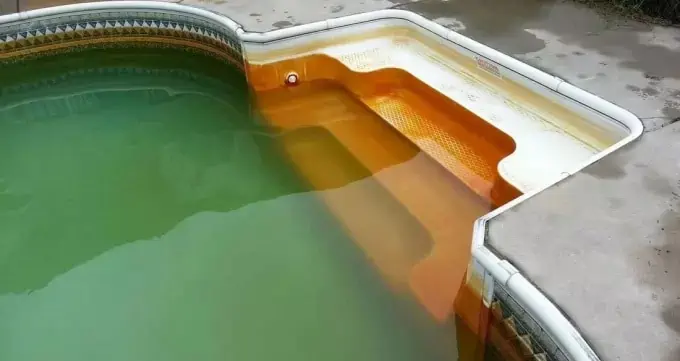If you have a pool and notice discoloration or staining of your hair, nails, or other body parts, it is most likely due to the high iron concentration of the pool water. Iron naturally exists in water which won’t create any problems.
However, the corrosion of pool equipment adds extra iron to your pool, which affects the water quality. Corrosion occurs over time when chlorine concentration rises and falls in pH levels. Excess iron in pool water appears cloudy, red, brown, black, gray, or green discoloration.

Before we discuss how to remove iron/rust from pool water, it is important to understand the consequences of having iron in the water. How do you identify water with a high iron concentration? Let’s discuss them all first and then come up with a quick solution to get rid of high iron levels in pool water.
How Does Iron Get Into Pool Water?
The fourth most prevalent metal in the earth’s crust is iron. The metal has a lovely silver sheen, but it corrodes when exposed to water and air. Iron is commonly present in fill water. If the source is a well, it may include iron metal in its ionic form.
Metals are collected in the pipe or plumbing network before the water reaches the pool when it is purified. This corrodes the pipelines and other pool equipment through which it runs over time.
How To Identify It?
A few major signs can help detect iron infiltration in your pool.
First, You may notice a strange smell in or around the water. At high concentrations, it may smell like sewage or rotten eggs. Second, you may notice rust stains, slime, and discoloration in certain parts of your pool and plumbing equipment.
If your pool contains a high amount of copper, it will look green. On the other hand, if it has a high concentration of iron, your pool will look rusty brown.
Remember that this does not happen all the time, and testing the water may reveal a different result. So, don’t come to any conclusion until you test it. Lastly, you can take a sample of your pool water to your local pool store for the iron test.
How To Remove Iron From Pool Water
Follow this 6-step procedure to remove iron from your swimming pool water completely.
Step 1: Check For The Presence of Iron
Various factors can stain your pool walls or create skin problems. To ensure that you are really dealing with iron, you need to confirm its presence first. An iron test kit specially designed for pool water will let you know whether iron is the source of your pool’s problems.
Staining and clouding generally occur when iron is present at 0.2 parts per million (PPM). The good news is that the test kit is sensitive enough to identify as little as 0.2 PPM of iron concentration in the water.
You can also take a sample of your pool water and send it to your local pool supply store for testing. After that, you will be able to know for sure whether iron is the culprit.
Step 2: Properly Shock the Pool
Once you know that you are dealing with iron, you need to shock the pool, following up with a clarifier treatment to reduce the iron buildup. Usually, shock treatment is of two types:
- Chlorine-based shock and
- Non-chlorine-based shock.
Vinyl pools require one type of shock, while gunite pools require a different one. So if you cannot determine the type of shock you need, seek advice from a pool expert. Wear all the necessary personal protection equipment, such as glasses and gloves, before you proceed.
Run the pool for 6-8 hours while performing the shock treatment; it will destroy harmful contaminants in the pool water. Use your pool pump to stir the water. Scrub the pool’s sides to dislodge any iron that has become stuck to the pool’s walls.
Step 3: Use a Pool Flocculant
Following the shock, use a good flocculant to remove the iron. Add the right amount of flocculent to the pool. Before adding the flocculant, you should first backwash the filter.
The flocculant will mix with the water to attach itself to the iron and pull it to the bottom of the pool. Add a quarter gallon of flocculent for every 6,500 gallons of pool water. This is something you can figure out based on the size of your pool.
Step 4: Pool Vacuuming and Backwashing
Once the shock, clarifier, and flocculent treatments are complete, the final step is to manually or automatically vacuum your pool, followed by a final backwash. This will remove the iron sediments from the bottom of your pool.
Step 5: Prevent From Oxidizing
Prevent the metal from oxidizing by adding a chelating or sequestering agent. The added agent forms complexes with the metal present in the pool.
Step 6: Manage pH Levels
Maintaining the pH level of the pool water between 7.2 and 7.6 will help to remove and prevent iron stains. This is important because it ensures that not just iron but also other impurities do not stain your wonderful pool.
However, unlike most other steps on this list, the last one is not a one-time event. Because the pH of a frequently used pool is prone to change, you would need to monitor your pool regularly to ensure it remains within acceptable values. Doing this once a week should be sufficient.
Conclusion
Now you know all about removing iron from the pool water. As soon as you suspect a high concentration of iron in your pool, take a water sample to your nearest pool store for testing. You can then follow the steps mentioned above to remove the iron from the pool water.
Once you’ve followed the procedure to remove iron from the pool properly, you can resume routine pool maintenance operations while also taking precautions to prevent recurring situations.